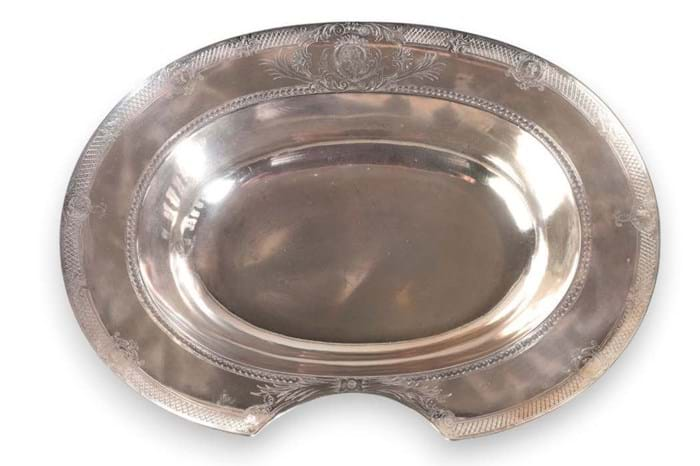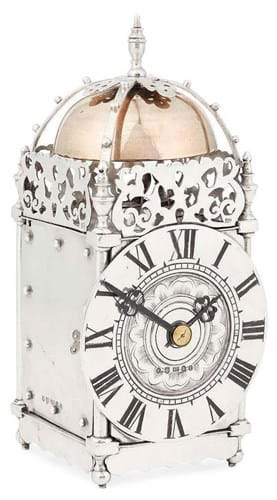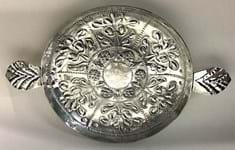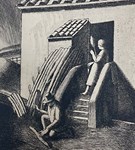Among the eye-catching lots at the extensive general sale at Metz in Heidelberg on March 22-23 is an impressive Georgian hot water urn made by the London silversmith John Robins and marked for 1803-04.
Robins was apprenticed in 1764 and registered at several locations in London as a plate worker and goldsmith until his death in 1831. Even though his repertoire included – on rare occasions – Torah finials and pointers, his speciality was household tableware such as tureens, teapots, sugar bowls, cream jugs and such hot water urns.
Measuring 20in (52cm), this example is, however, considerably taller than many of the other known urns by Robins. Furthermore, it is more exuberantly decorated. While the majority of his pieces have a smooth, polished surface with restrained, generally engraved decorations, the water urn in Heidelberg is completely covered with embossed floral motifs and garlands.
Like the other lots in the sale, Robins’ water urn is being offered without reserve.
De Lamerie shaving bowl
When Duke’s of Dorchester offers the contents of Sandford Orcas Manor in Dorchester on March 6 a highlight of the silver wares will be this shaving bowl by the highly regarded London silversmith Paul de Lamerie.
The 13in (33cm) wide bowl weighing c.30 troy oz, is of typical form with an indent to one side of the broad rim and has a maker’s mark for de Lamerie for London 1724 and features a diaper and strapwork border punctuated by classical busts. It also has a central armorial for James Medlycott (1658-1771) for whom it was made and has passed down by descent through the family.
It is fitting that Medlycott employed the leading silversmith of his generation for his personal shaving bowl, notes the catalogue.
Having made a fortune as a lawyer and Master in Chancery, Medlycott purchased a seat in Parliament and set about building one of the most beautiful late Baroque houses in the kingdom, Ven House at Milborne Port. The house remained in the family until the mid-20th century when many of the contents were transferred to the Medlycotts’ other seat at Sandford Orcas Manor.
Estimate £15,000-25,000.
Rich picking
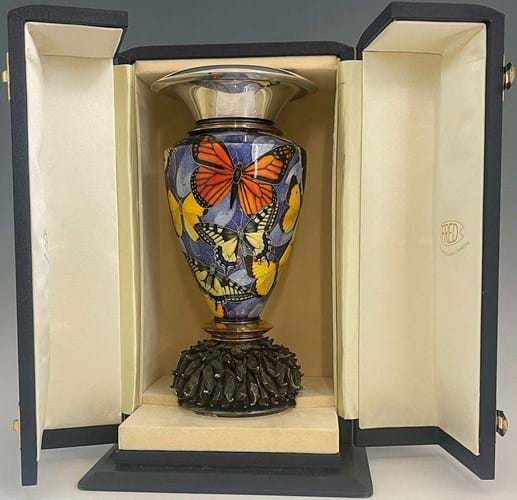
Enamelled silver vase by Fred Rich in its fitted presentation case to be offered by Kinghams, estimate £3000-5000.
Discovered in a Cotswold manor house tucked away on a window ledge, this silver and polychrome enamelled vase is by the British art enameller Fred Rich whose work is featured in many private and public UK collections. It will be offered in Kinghams’ silver and vertu sale in Moreton-in-Marsh on March 22.
The vase, which weighs almost 2.3kg and is almost 10in (25cm) in height, is a large example of Rich’s painstaking enamelling technique. This requires the design to be scribed onto the surface before the pieces of 22ct gold wire are cut and bent to shape and soldered followed by the application of several layers of enamel fired at high temperatures with larger pieces fired up to 40 times.
The underside of the vase is signed Fred Rich, and struck with the millennium mark, sponsor’s mark, FR in quatrefoil surround, and hallmarked for London 2000.
Estimate £3000-5000.
Here to serve
Lantern clocks, the first type of clock widely used in private homes, were largely obsolete as timekeepers by the mid-18th century. However, during the Victorian era they began to attract the interest of antiquarians.
This unusual 8½in (22cm) example was made in silver by Alexander Chalmers of Edinburgh in 1887. An inscription on the back in mock olde English reads: I serve ye here wythe all my myghte to tell ye hours by daye and nyghte, therefore example take by me and serve thy God as I serve ye.
It carries an estimate of £1200-1500 as part of Lyon & Turnbull’s March 5 sale of silver and vertu in Edinburgh.




